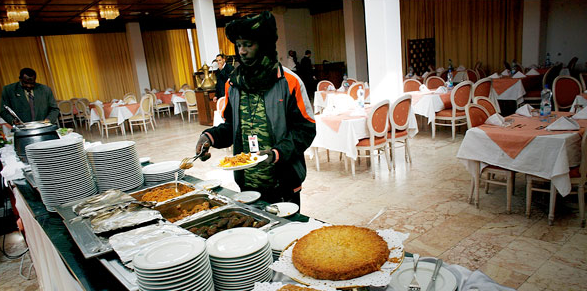This image is at once unusual and deeply familiar, no matter where you imagine it taking place.
The incongruity comes, of course, from seeing a dude in gangsta attire going down a buffet line within what looks like the perfect example of the Generic Hotel banquet room. More to the point, this guy is out of place, whether the place is Libya, where he actually was, or Atlanta or Chicago or any other city center.
For all that, the scene will be all too familiar to many viewers. This is the generic modernity inhabited by the middle class whether they are at work or at a wedding or some other weekend event. If you’ve seen one room like this, you’ve seen them all. And for all the effort that goes into pretending that today’s buffet is better than the rest, it rarely is. This one doesn’t even make the effort. The tackiness of the scene becomes obvious because of how he looks–that cheap jacket makes the aluminum warmers and stacked plates all the more obvious–while the long view exposing the table legs and chair backs makes all the decor seem all too typical.
And this is where things get interesting. The New York Times story captioned by the picture was titled “Rebel Unity is Scarce at the Darfur Talks in Libya.” It seems that the big fish boycotted the peace conference, leaving only small fry like our man at the buffet line. No one was interested in talking with the lesser lords of the desert, who were left to kill time in the hotel. In fact, the story reported that those present usually descended on the buffets together, but the photographer obviously wanted to show something other than eating.
So, what is being shown? It could be that small tribal leaders are out of place in modern diplomatic settings. Since he doesn’t really belong there–as you can see just by looking at him–then he ought to go back to the Darfur “street” from whence he came. In short, he shouldn’t have presumed to be there at all. (Never mind that he will have come at personal inconvenience, expense, and risk, and that he probably is able to wreak havoc somewhere if so inclined.)
That interpretation might do, but I think the photograph deconstructs on precisely that point. For one, he is behaving exactly as he should; from the measured manner in which he is holding the serving tongs, it looks as though he’s been through a buffet line many times. More important, the tackiness of the rest of the scene speaks volumes. The problem isn’t that he’s there, but that the room is otherwise empty (save for the single waiter at the end of the table). The room itself looks like a mere shell, an artificial trompe l’oeil of modern life superimposed on the backdrop of the desert, clan politics, and constant cycles of violence. Perhaps the conference would have worked had the room been full of all the leaders and their entourages, but this photograph hints otherwise.
Maybe the problem isn’t the homeboy but the hotel. More precisely, perhaps the problem is that peace is no more to be brokered in the neutral space of Generic Modernity than it could be found in the dangerous places of the Darfur borderlands. Nor are the scenes themselves the problem. The hotel, like the desert, brings with it a particular conception of politics, negotiation, and peace. Each activates different modes of organization, modes of speech, and images of the future. My guess is that if peace is to come to Darfur, and to many other places around the world, those involved will have to find another place to meet that is neither the war zone nor the modern hotel. That is, they will have to find another way to talk and think together that is neither entirely outside of modernity nor within its most typical structures and assumptions.

Is there really such a thing as a Generic Modernity, one that is the same the world over? Your characterization of the photo’s subject as a “homeboy” erases the possibility of a counter-modernity. The terms “homeboy” and “gangsta” are U.S. in origin and gesture vaguely toward a U.S. black consumer market. To suggest that this person looks out of place is to impose a narrow, ethnocentric view. He only looks out of place at the Hilton Libya because there’s a good chance he would look out of place at a diplomatic event held at the Hilton Chicago. But, as evidenced by the photo, he is very much in place. His presence suggests that headphones and workout suits, and indeed African-American cultures have a place in international political affairs in a way totally denied in U.S. society. While the emptiness around him suggests perhaps he is ignored also on the world stage, his presence suggests that other nations do not construct their socio-political identity merely in imitation of U.S. culture.
K, we see things much the same. I may not have been as clear as I wished, but my use of “homeboy” was somewhat ironic, in the same way that I don’t know whether the hotel is actually a Hilton. Although the Times article emphasized that he was out of place, and this photo and the other photos in the essay would seem to underscore that point for a US audience, my point was that the problem may be not him but the place. There is a generic modernity constructed by hotels, airports, and the like, but it is only one of various alternative modernities, some still emerging, and I doubt it is the best place for bringing people together to solve difficult problems of conflict resolution.
generic prescription no adipex next prescription adipex no